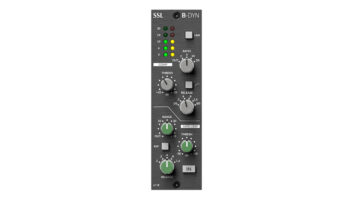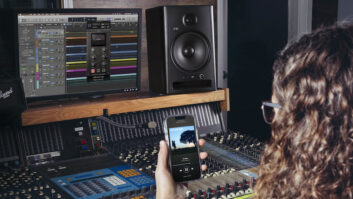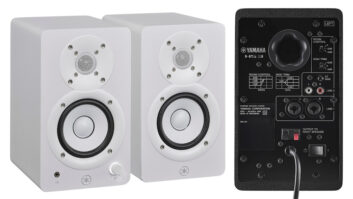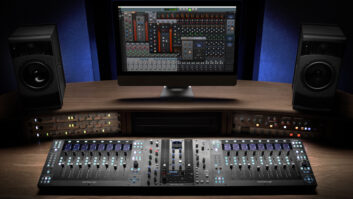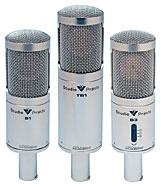
During the past few years, there has been an explosion of almostunbelievably low-priced Chinese condenser mics that look like prizedGerman beauties. But while they look similar, not all of these mics arecreated equal. Some are shoulder-shruggingly okay, and some are prettygood. However, Studio Projects’ B Series, a new line of mics that looklike little U47s, range from only $100 to $350 list and sound betterthan pretty good.
STRIPPED DOWN TO THE FACTS
The B Series comprises three large-diaphragm (1-inch) models: thecardioid-only B1; the multipattern, dual-capsule B3; and thecardioid-only TB1, which uses a tube and comes with a separatedual-voltage (115-volt or 230V) power supply. Although the B1 and TB1do not have controls, the B3’s 3-position switch lets you choose eithera highpass filter or a -10dB pad.
While the build quality of these mics is adequate, they do vibrate alittle when you tap their bodies, as the manufacturer readily admits,but they certainly don’t rattle or feel rickety. Studio Projectsrecommends using a shock-mount to combat the vibration, and thecustom-fitted one provided holds the mics snugly in position. Thisshock-mount is an improvement over those generic ones with the rubberband in the middle or the nylon cord that quickly loses itselasticity.
The B1 and B3 come in plastic zipper bags, and the TB1 comes in afoam-lined briefcase that holds the mic, power supply and cables, butnot the shock-mount. All three models come with a foam windscreen.
THE TEST DRIVE
I ran these mics through a Millennia Media STT-1 channel strip usingits solid-state setting with the transformer switched out. This makesthe preamp about as neutral as you can get; impedance considerationsaside, what you hear is the mic and not the preamp.
You do hear a noticeable quality improvement as you go up the BSeries line. However, even the B1 sounds quite a bit better than theShanghai U87-alike I compared these mics to, and it sells for the sameprice.
The exception is that the Shanghai mic sounded better than any ofthe Bs on male voice-over, but that’s almost certainly due to off-axisreflections picked up by the Bs’ wider pickup patterns. (This includesthe B3 in cardioid mode.) The wide cardioid does make them moresensitive to what’s going on off-axis, so be mindful of things likenearby walls when you’re positioning them. A strategically placedAuralex Max Wall, which is a couple of sideways 2×4-foot foamsheets impaled on a mic stand, can really help.
The B’s performance with what’s in front of the mic is surprisinglygood. Some side-by-side male vocal recordings through the TB1 and a$2,000 RØDE Classic II — an undeniably great mic —were a real eye-opener. The RØDE definitely sounded bigger (and infact, it is bigger!) and is more midrange-forward, but I couldn’t saythat the TB1 sounded worse in this application — justdifferent.
Normally, you can identify inexpensive mics right away by theirsteely high end, but the TB1’s high end is smooth and open, toe-to-toewith the RØDE — very impressive. While the solid-state mics(B1 and B3) aren’t quite as nice overall, they do share the same soundquality.
The TB1 has a noticeable amount of the typical “tube”sound, a buttery effect that you hear on the transients and not verydifferent from tape compression. That isn’t always what tubes do, butin this case, it’s reasonably descriptive. The effect is quite obviouson shaker, a broadband instrument that behaves almost like pink noisewith transients, and can really point out what a mic does to thesound.
Studio Projects bills all three models as general-purpose recordingmics, which is fair, as they have some character and a slightlyrecessed midrange, but the sound isn’t colored enough to relegate theBs to specialty mic status. The Bs work on a lot of instruments thatmany users wouldn’t think of recording with a large-diaphragm mic. Forexample, I wouldn’t normally mike a solo cello with a large-diaphragmmic, but the B1 didn’t bring out the resonances to excess. That’s notto say that it would be my first choice, but it does work. The TB1’srecessed midrange sounded good on alto recorder. It also sound okay onacoustic guitar, although it’s certainly not rare to use alarge-diaphragm condenser in that application.
The B Series mics also did well on instruments that are normallycaptured with a large-diaphragm mic., such as close up on an uprightpiano. The proximity helped bring out some of the low end on a smallpiano that’s pretty weak at the bottom.
Two B3s or a B1 and a B3 would make a very nice budget M-S mikingsetup. The B3s’ 14dBA noise rating (12dBA for the B1) proves thatthey’re quiet enough to use some distance from the source, which wouldalso make them good choices as room mics.
Even though the TB1 is noisier than the other two (18 dBA), its tubecircuitry gives it a rounder sound that makes it very appealing. The B1and B3 specs list a 132dB SPL handling ability (128 dB for the TB1), soyou’re not likely to blow these mics out in front of a guitar amp.Their output is hot enough to allow the preamps they’re feeding tooperate at a comfortable, quiet range.
THUS
It’s pretty scary that mics this inexpensive can sound this good. Byall rights, the $100 B1 shouldn’t even be usable, and the $200 B3shouldn’t be a dual-capsule model with switchable patterns. But if youhave to choose one of the three to get excited about, it’s the TB1, a$350 tube mic that stands up to world-class mics that cost more thanfive times as much.
Studio Projects, dist. by PMI Audio Group, 877/563-6335, www.pmiaudio.com.
Nick Batzdorf is a composer, audio and music toy boffin, andwriter.

